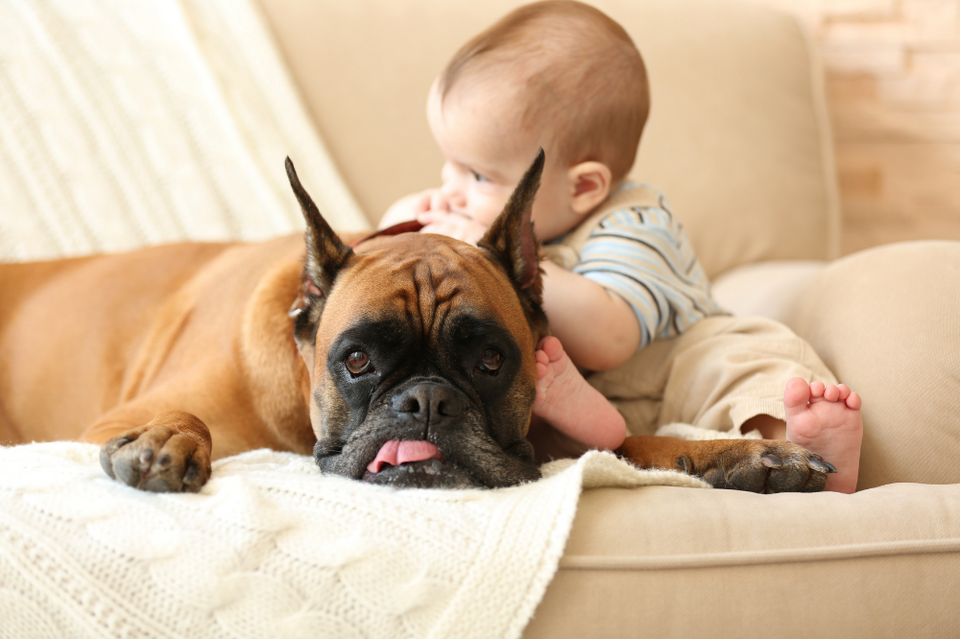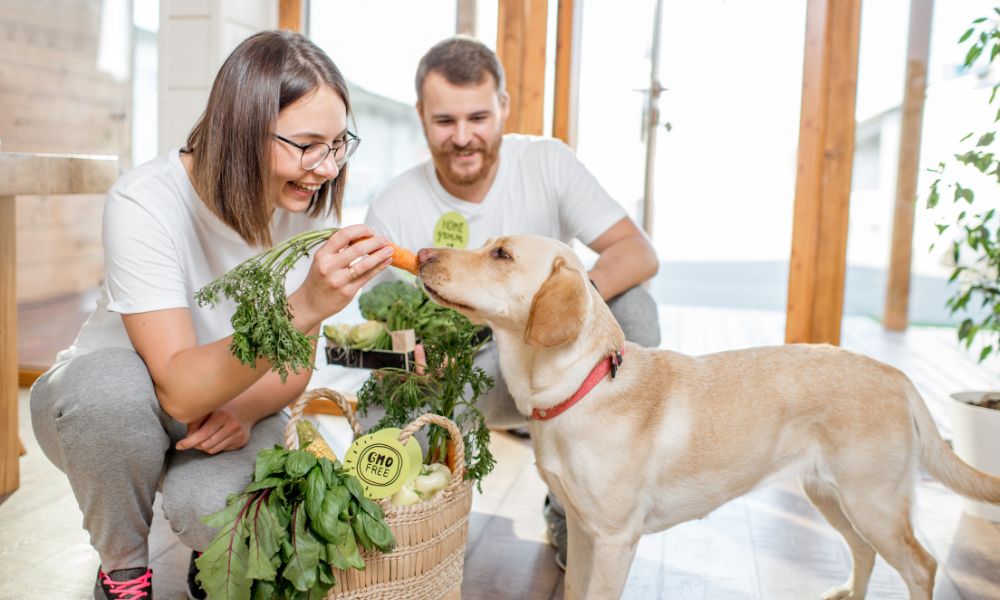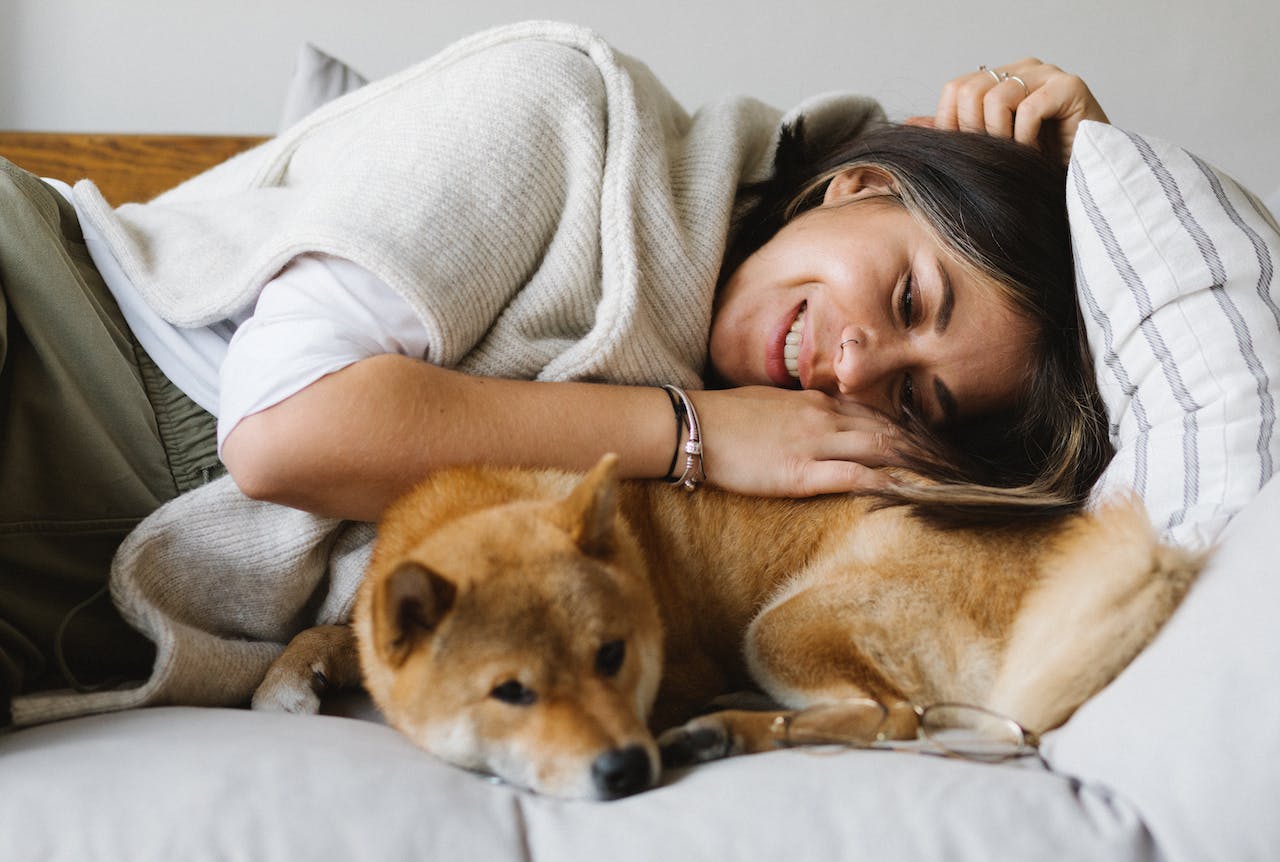
Do’s & Don’ts of Introducing Your Pet to a New Family Member

Sometimes families and households change. It can happen when a child is born, a couple marries, or a roommate or parent moves in. It can also change when you adopt a new pet.
Humans, of course, are capable of preparing for the change because they know about it in advance. Our pets, however, can’t plan ahead, so suddenly bringing that new person or animal into the home can be a big surprise if you don’t prepare them for it.
Fortunately, there are things you can do to help your dogs and cats adjust to the changes.
And baby makes four (or more)
The nice thing about having a baby is that you get up to nine months to prepare for it — planning and creating the nursery, stocking up on things you’ll need, learning about the birthing process, finding a pediatrician, and (naturally) preparing your pets.
To prepare your dog, it’s best to start by training them that the nursery is off limits for now and that they can only enter with your permission. Before the baby arrives, invite your dog in from time to time and allow them to sniff around and get used to new things.
For a cat, the process is the opposite. Let them explore the room for a couple of weeks long before the baby comes home, and then teach them which surfaces they aren’t allowed on, like the changing table or in the crib itself.
Once the baby has arrived, you should never allow the cat in the nursery while your child is sleeping, setting up some sort of barrier or screen door that the cat can’t get past. This is just a good practice, though. The idea that a cat will suck away a baby’s breath is a myth.
Your dog is probably fine, provided that they’re not inclined to jump into the crib, and will probably show a lot of curiosity about this new creature.
An important thing to remember, especially with dogs, is to keep an eye on the emotional energy in the house. Pregnancy can be a difficult time for expectant mothers because of the hormonal storm they’re experiencing, not to mention the physical and psychological effects of carrying a child.
Your dog will pick up on any tension or anxiety happening among the humans and reflect it, so make sure you monitor it and distract the dog (and yourself) from it with a nice walk or playtime.
For dogs and cats, change your schedule early if you know that baby time will affect walk or feeding time.
Leading up to the arrival, it’s a good idea to get all your pets used to the new smell. At the very least, see if you can get a receiving blanket from the hospital where the baby will be born so you’re bringing home at least that unique medical scent. If at all possible, try to bring home a burp cloth or other item that your newborn has actually touched before you bring the baby home.
In the case of cats, if there are particular lotions or powders with scents that you’re going to be using with the baby, start using them early so your cat can get used to the smell. It’s also a good idea to play the sounds of infants and babies well in advance to get your cat used to them.
When you do bring the baby home, someone should take the dog on a walk before the arrival, then have them wait before entering the house. They’ll probably smell the presence of the infant right away.
The mother or father should be holding the baby while remaining completely calm. At this point, allow the dog to sniff the baby from a distance, but not to approach yet. That can happen gradually.
Most importantly, after the arrival be sure to give your dogs and cats plenty of affection and attention so that they don’t feel “replaced.”
Instant family

Not all additions to the household are newborns. Children and teenagers can also arrive via adoption or marriages that lead to blended families. You don’t need to go through as much preparation as with a baby, but you still need to ease the transition.
You’re definitely going to know ahead of time that new kids and a spouse might be joining the household, so you’ll have plenty of time to prepare.
With adoption, you absolutely need to see the new children with your pets, especially if they’re toddlers or older, to make sure they don’t have any issues interacting with animals. Likewise, the adoption agency will need to assess whether children will be safe around your pets.
In the case of a blended family, chances are that your dogs and cats have already met your betrothed many times. They may not have met the children, but now you have an ideal opportunity for a family outing with the dog so they can get used to the new arrivals.
With the cat, not so much. But in either case, you’ll also need to create a safe space for your pets before the new arrivals move in. This is basically a room with their food, water, and a comfy bed, plus their crate if you have one.
Nobody but their original pet parent should be allowed to enter when they’re in there until they’ve gotten used to the new family members. Also keep in mind that each cat will require a separate safe room if you have more than one.
Eventually, let the kids help out with feeding your pets and walking the dogs. Just keep in mind that, in the case of teens, never make it a chore that they have to do. Rather, offer it as something they can take care of if they want to. This will help prevent them from developing any kind of resentment toward your pets.
It’s also vital that you know your pets before a change like this happens. Some dogs and cats can be fearful of children and even tweens and teens, so they’ll need extra help in adjusting to them, and possibly even behavioral training. Others can be very social around new people and be friendly right away.
It’s up to you to know what to expect from your pets and prepare accordingly.
New adults
New adults can be much easier to bring into the household because you’re able to plan with them. Typically, you should go through the same first meeting outside the home on a walk unless your dog is already familiar with the new roommate or family member.
If the new resident is a parent of one of the adults in the household, then the pets probably already do know them.
For dogs, in preparation for the move-in, get an article of clothing, like a shirt, from the person, let your dog sniff it, then put it in the room where the new housemate will be staying. This will get your dog used to the idea of their presence.
For cats, you need much the same procedure you used for new children or teens — creating a safe space where they can be alone and that only you enter until they become used to the sounds and smells of the new people.
Do let your cats meet the new residents long before they move in, but only for very brief periods of time.
One thing to be aware of is whether your pets have any fear of certain objects. Some dogs, for example, are naturally fearful of anything resembling a pole, like brooms.
If you have an elderly parent coming in who needs a cane or uses a walker, be aware that both of these can startle or frighten your pets. A cane can cause a dog or cat to become fearful of being hit, and the motion of a walker can appear threatening to them, as if a predator is slowly stalking them.
Again, acclimation is the key. Buy a cane or borrow or rent a walker ahead of time and just bring it into the house so your pets can get used to them when they’re not being used. As they seem to get more comfortable, you can use these devices for very short periods of time so that your pets will learn not to fear them.
Furry flatmates
Finally, we come to the addition of new animals to the household, which can be the trickiest change of all. The procedures are also very different for dogs and cats.
A very important rule with dogs is that if you have a female already, you should not bring another female into the house. Surprisingly, female dogs are much more likely to show aggression toward each other. Males are much less likely, especially if they’re neutered. The safest pairing is one female and one male.
Next, remember that you’re bringing the new dog into the resident dog’s territory, so it has to be by invitation. Always meet up with the new dog on a walk in an unfamiliar neighborhood.
Have a family member or friend already known to your dog meet you with the new dog. Let the dogs greet each other, then take them on a walk together. This forward motion through a strange area will keep both dogs focused on sniffing all the unknown scents and hearing all the new sounds and it’s really the best way to help them bond quickly.
Eventually, you can all return home. Once there, bring your dog in first while having the new dog wait, then explicitly invite them in. Leave the new dog on leash and the resident dog off, then give a guided tour of the house. Be sure that there are no food bowls or chew toys set out during this process. Water is fine.
One very important thing to remember with dogs is this: Avoid the inclination to automatically consider your current dog to be the “boss.” This works with human children because older children are more mature, but with dogs it’s different.
You basically need to let them decide which one is the dominant dog, which they’ll know pretty much immediately, and then follow their lead. Don’t feel guilty if your resident dog takes on the submissive role — it’s what they want.
Regarding introducing cats, the gender issue applies doubly, so you should never add a cat of the same sex as the one you have. The exception is if you bring in a kitten or are bringing two kittens together.
Otherwise, the introduction is a slow and gradual process that can take anywhere from eight to twelve months. It involves keeping them in separate rooms for a while, letting the new cat explore the space while the old cat is confined. They should not be able to see or touch each other, only hear and smell.
They should each have their own separate beds, food and water bowls, and litter boxes.
In order to facilitate them getting used to each other, feed them on opposite sides of the same door. They’ll become aware of each other’s presence and associate it with the pleasant experience of eating.
After a few days, switch the cats’ locations. This will allow them to get more familiar with each other’s scents. If, after a week, you’ve seen no signs of aggression, like hissing at the door, then it’s time to let them see each other.
For this, You need to put a barrier that can’t be jumped in the doorway. A temporary screen door is ideal, but you can also use two stacked baby gates. You’ll need someone to help, with one person and one cat on either side of the barrier.
Set the cats down a few feet from the doorway. When they notice each other, say their names and toss treats to them, aiming them to land behind the cat. The goal here is to spend some time each day giving treats to the cats and engaging in playtime while they can see each other, creating another pleasant association.
Eventually, it will be time to remove the barrier and let the cats be together for short periods. Ideally, you should do this when they’re both calm, like after a big meal or some strenuous play.
Always supervise these interactions and have a squirt bottle handy in case they do start to show aggression. Gradually lengthen the time that they’re together.
Yes, cats are more complicated than dogs in this regard.
Home sweet home
Eventually, everyone will be used to everyone else, and your new household will fall into its new routine. Don’t be too concerned if there are any glitches along the way, but do take steps to correct any sudden unwanted behavioral issues as soon as they crop up.
In the case of babies and small children, you may be surprised to see how they bring out your dog’s parental instincts, and having a baby around might make your cat a lot more talkative. Having a dog around might also make your teen a lot less moody.
It can take work to deal with household changes and pets, but it’s always worth the effort. It’s also a good reminder of something we should always be aware of: Our fur babies are a part of the family, too, and always will be.
Share this article
written by


